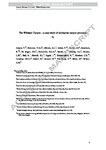The Whittard Canyon - A case study of submarine canyon processes
| dc.contributor.author | Amaro, T | |
| dc.contributor.author | Huvenne, VAI | |
| dc.contributor.author | Allcock, AL | |
| dc.contributor.author | Aslam, T | |
| dc.contributor.author | Davies, JS | |
| dc.contributor.author | Danovaro, R | |
| dc.contributor.author | De Stigter, HC | |
| dc.contributor.author | Duineveld, GCA | |
| dc.contributor.author | Gambi, C | |
| dc.contributor.author | Gooday, AJ | |
| dc.contributor.author | Gunton, LM | |
| dc.contributor.author | Hall, R | |
| dc.contributor.author | Howell, Kerry | |
| dc.contributor.author | Ingels, J | |
| dc.contributor.author | Kiriakoulakis, K | |
| dc.contributor.author | Kershaw, CE | |
| dc.contributor.author | Lavaleye, MSS | |
| dc.contributor.author | Robert, K | |
| dc.contributor.author | Stewart, H | |
| dc.contributor.author | Van Rooij, D | |
| dc.contributor.author | White, M | |
| dc.contributor.author | Wilson, AM | |
| dc.date.accessioned | 2016-09-17T14:32:54Z | |
| dc.date.available | 2016-09-17T14:32:54Z | |
| dc.date.issued | 2016-08 | |
| dc.identifier.issn | 0079-6611 | |
| dc.identifier.uri | http://hdl.handle.net/10026.1/5457 | |
| dc.description.abstract |
Submarine canyons are large geomorphological features that incise continental shelves and slopes around the world. They are often suggested to be biodiversity and biomass hotspots, although there is no consensus about this in the literature. Nevertheless, many canyons do host diverse faunal communities but owing to our lack of understanding of the processes shaping and driving this diversity, appropriate management strategies have yet to be developed. Here, we integrate all the current knowledge of one single system, the Whittard Canyon (Celtic Margin, NE Atlantic), including the latest research on its geology, sedimentology, geomorphology, oceanography, ecology, and biodiversity in order to address this issue. The Whittard Canyon is an active system in terms of sediment transport. The net suspended sediment transport is mainly up-canyon causing sedimentary overflow in some upper canyon areas. Occasionally sediment gravity flow events do occur, some possibly the result of anthropogenic activity. However, the role of these intermittent gravity flows in transferring labile organic matter to the deeper regions of the canyon appears to be limited. More likely, any labile organic matter flushed downslope in this way becomes strongly diluted with bulk material and is therefore of little food value for benthic fauna. Instead, the fresh organic matter found in the Whittard Channel mainly arrives through vertical deposition and lateral transport of phytoplankton blooms that occur in the area during spring and summer. The response of the Whittard Canyon fauna to these processes is different in different groups. Foraminiferal abundances are higher in the upper parts of the canyon and on the slope than in the lower canyon. Meiofaunal abundances in the upper and middle part of the canyon are higher than on adjacent slopes, but lower in the deepest part. Mega- and macrofauna abundances are higher in the canyon compared with the adjacent slope and are higher in the eastern than the western branch. These faunal patterns reflect the fact that the Whittard Canyon encompasses considerable environmental heterogeneity, related to a combination of organic matter trapping, current regimes (due to focused internal tides) and different substrates. We conclude that coordinated observations of processes driving faunal patterns are needed at a fine scale in order to understand the functioning of communities in this and other submarine canyons. | |
| dc.format.extent | 38-57 | |
| dc.language | en | |
| dc.language.iso | en | |
| dc.publisher | Elsevier BV | |
| dc.title | The Whittard Canyon - A case study of submarine canyon processes | |
| dc.type | journal-article | |
| dc.type | Review | |
| dc.type | Journal | |
| plymouth.author-url | http://gateway.webofknowledge.com/gateway/Gateway.cgi?GWVersion=2&SrcApp=PARTNER_APP&SrcAuth=LinksAMR&KeyUT=WOS:000382341800003&DestLinkType=FullRecord&DestApp=ALL_WOS&UsrCustomerID=11bb513d99f797142bcfeffcc58ea008 | |
| plymouth.volume | 146 | |
| plymouth.publication-status | Published | |
| plymouth.journal | PROGRESS IN OCEANOGRAPHY | |
| dc.identifier.doi | 10.1016/j.pocean.2016.06.003 | |
| plymouth.organisational-group | /Plymouth | |
| plymouth.organisational-group | /Plymouth/Faculty of Science and Engineering | |
| plymouth.organisational-group | /Plymouth/Faculty of Science and Engineering/School of Biological and Marine Sciences | |
| plymouth.organisational-group | /Plymouth/REF 2021 Researchers by UoA | |
| plymouth.organisational-group | /Plymouth/REF 2021 Researchers by UoA/UoA07 Earth Systems and Environmental Sciences | |
| plymouth.organisational-group | /Plymouth/Research Groups | |
| plymouth.organisational-group | /Plymouth/Research Groups/Marine Institute | |
| plymouth.organisational-group | /Plymouth/Users by role | |
| plymouth.organisational-group | /Plymouth/Users by role/Academics | |
| plymouth.organisational-group | /Plymouth/Users by role/Researchers in ResearchFish submission | |
| dcterms.dateAccepted | 2016-06-13 | |
| dc.rights.embargodate | 2017-6-18 | |
| dc.rights.embargoperiod | 12 months | |
| rioxxterms.versionofrecord | 10.1016/j.pocean.2016.06.003 | |
| rioxxterms.licenseref.uri | http://www.rioxx.net/licenses/under-embargo-all-rights-reserved | |
| rioxxterms.licenseref.startdate | 2016-08 | |
| rioxxterms.type | Journal Article/Review |


